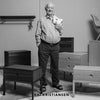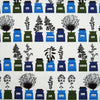HOUSE OF THE FUTURO


Above: A new Futuro House in the 1960s. Photo: FuturoHouse.net
The Futuro House was designed by Matti Suuronen as a portable ski chalet in 1968. In total, less than 100 were built during the late 1960s and early 1970s. The Futuro is constructed of reinforced fiberglass, polyester-polyurethane, and measures 13 feet high and 26 feet in diameter. A restored Futuro House at The Terrace, Central Saint Martins, King's Cross. Photo: http://blogs.arts.ac.uk/
A restored Futuro House at The Terrace, Central Saint Martins, King's Cross. Photo: http://blogs.arts.ac.uk/
 Inside a restored Futuro House, at The Terrace, Central Saint Martins, King's Cross. Photo: http://blogs.arts.ac.uk/
Inside a restored Futuro House, at The Terrace, Central Saint Martins, King's Cross. Photo: http://blogs.arts.ac.uk/

 Vintage Futuro House interior. Photo: Cult of Weird
Vintage Futuro House interior. Photo: Cult of Weird
-
Posted in
Category_BLOG, futuro





